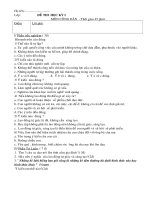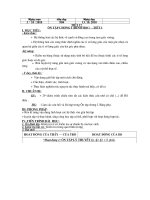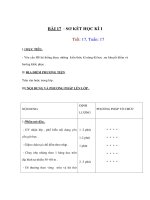Lecture 17 - hematology - Huyết học
Bạn đang xem bản rút gọn của tài liệu. Xem và tải ngay bản đầy đủ của tài liệu tại đây (1.21 MB, 37 trang )
1
Hematology
2
Basic scheme
Blood leaves the heart in
arteries
Branching of arteries until
they become tiny capillaries
Oxygen and nutrients diffuse out
CO2 and wastes diffuse in
Capillaries form veins going to the heart
The blood leaves the right side of the heart for
the lungs to pick up O2 and release CO2
Blood goes back to the left side of the heart to
start all over
Note: vessels going to the heart are veins; those leaving the heart are arteries
3
Composition of blood
Specialized connective tissue
Blood cells (formed elements) suspended in
plasma
Blood volume: 5-6 liters (approx 1.5 gal) in
males and 4-5 liters in females
4
Blood
Centrifuged (spun) to separate
Clinically important hematocrit
% of blood volume consisting of erythrocytes
(red blood cells)
Male average 47; female average 42
Plasma at top: water with many ions,
molecules, and 3 types of important
proteins:
Albumin
Globulins
Fibrinogen
5
Serum
Blood that is allowed to stand clots
Clot is a tangle of the “formed elements” (some are
not truly cells)
RBCs lack nuclei and organelles
Platelets are fragments
Most cannot divide
Clear fluid serum is left = plasma without the clotting
factors
When spun in centrifuge,
buffy coat lies between
RBCs and plasma: of
leukocytes (white blood
cells) and platelets
6
Blood is
examined in a
“smear”
Smears are
stained
Scanning EM
Light microscope
7
Hematopoiesis
Formation of blood cells
Occurs mostly in red bone marrow
All cells arise from same blood stem cell
(pluripotent hematopoietic stem cells)
Recently some have been found in adults
which are mesenchymal stem cells,
which can also form fat cells, osteoblasts,
chondrocytes, fibroblasts and muscle cells
8
9
Blood stem cells divide into:
1.myeloid stem cells or
2.lymphoid stem cells
All except for
lymphocytes arise
from myeloid
stem cells
All originate in the
bone marrow
Not shown are
mast cells,
osteoclasts,
dendritic cells
10
As the cells divide they become
“committed,” that is, they can only become
one kind of cell
Also called CFU’s (colony-forming units)
Structural differentiation occurs
11
CBC is probably commonest test done
(“complete blood count”-how much of each type of cell)
Hemoglobin (gm/dl)
usually 15
Hematocrit (%)
RBC count
WBC in thousands/cumm
Differential if ordered:
broken down to amount of
each type WBC
Platelet count in
thousands/cumm
12
Erythrocytes
Also called RBCs or red blood
cells
Biconcave discs and flexible
Plasma membrane but no
nuclei or organelles
Packed with hemoglobin
molecules
Oxygen carrying protein
4 chains of amino acids, each
with iron which is binding site for
oxygen; CO2 carried also
Young ones still containing
ribosomes are called
reticulocytes
Live 100-120 days
heme
iron atom
13
Leukocytes
AKA WBCs:
white blood
cells
14
Leukocytes
AKA WBCs: white
blood cells
Are complete cells
Function outside
the blood
Note the size
difference compared
to erythrocytes
neutrophil eosinophil
basophil
small lymphocyte monocyte
__RBC
15
Leukocyte types
Artificial division into granulocytes and
agranulocytes
Granulocytes: neutrophils, eosinophils,
basophils (according to how stain)
Granules
Lobed nuclei
All are phagocytic
Agranulocytes: lymphocytes, monocytes
16
All except for
lymphocytes
arise from
myeloid stem
cells
All originate in
the bone
marrow
Not shown are mast cells,
osteoclasts, dendritic cells
Remember this slide?
See the artificial division?
17
Neutrophils
60% of all WBCs
Nuclei of 2-6 lobes
Other names:
Polymorphonuclear cells (PMNs, polys, segs)
Granules have enzymes
Can damage tissue if severe or prolonged
Pus
18
Eosinophils
1-4 % of leukocytes
Bilobed
Granules have digestive enzymes
Role in ending allergic reactions and in
fighting parasitic infections
19
Basophils
Rarest WBC
Bilobed nucleus
Dark purple granules
Later stages of reaction to allergies and
parasitic infections
20
Lymphocytes*
Most important
WBC
20-45%
Most are
enmeshed in
lymphoid
connective
tissue, e.g.
lymph nodes,
tonsils, spleen
*
21
Lymphocytes:
nucleus occupies most of
the cell volume
Response to antigens (foreign proteins or parts of cells)
is specific
Two main types attack antigens in different ways
T cells
B cells
plus “natural killer cells”
22
T cells attack foreign cells directly
Killer cells (“cytotoxic”), or CD8+ is a main
type
23
B cells
Differentiate into plasma cells
Plasma cells secrete antibodies
Antibodies flag cells for destruction by
macrophages (see stem cell chart)
24
Monocytes*
4-8% of WBCs
In connective
tissue they
transform into
macrophages
(phagocytic cells
with pseudopods)
*
25
Platelets*
Not cells
Small fragments
broken off from
megakaryocytes
Important in
forming clots in
damaged vessels
AKA
thrombocytes
*









